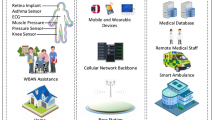Abstract
Advances made in the wearable and biosensor has attracted the applicability and usability of the healthcare applications. The biosensors collect the human physiological data from a remote area using wireless communication medium. Different form of security implications have to be exhibited in wireless body area networks (WBAN). This paper researches on enhancing the network layer and application layer of the WBAN in healthcare environment. The objective of the each phase is to enhance the data accuracy of the collected data with minimized delay. In the first phase, we have constructed attack model for Sybil, sinkhole and wormhole attacks and detected those attacks under different constraints. Secondly, an efficient packet transmission model which helps to transmit the sensed data based on their emergency using weighted product model. After devising network layer, a lightweight security scheme, an improved elliptic curve cryptography (ECC) that permits the data access for the authorized users. Experimental analysis is carried out for each phase under pre-defined simulation parameters which explores better results. The framed attack model detects the three eminent attacks in terms of false positive rate and false negative rate which helps the data controller for message transmission process. Likewise, we have also achieved 97% packet delivery ratio with 0.8 ms packet dropping ratio for better packet transmission model than the existing TOPSIS model. Time taken for key generation and secret key exchange using our proposed ECC achieved 2.4 and 0.96 ms. The overall system proves that our research model achieves scalable and fairness medical sensor networks system.








Similar content being viewed by others
References
He, D.: A novel and lightweight system to secure wireless medical sensor networks. IEEE J. Biomed. Health Inform. 18(1), 316–326 (2014)
Istepanian, R.S.H.: Telemedicine in the United Kingdom: current status and future prospects. IEEE Trans. Inf. Tecnol. Biomed. 3(2), 158–159 (1999)
Guillén, S., Arredondo, M.T., Traver, V., García, J.M., Fernández, C.: Multimedia telehomecare system using standard TV set. IEEE Trans. Biomed. Eng. 49(12), 1431–1437 (2002)
Lorincz, K., Malan, D., Fulford-Jones, T., Nawoj, A., Clavel, A., Shnayder, V., Mainland, G., Moulton, S., Welsh, M.: Sensor networks for emergency response: challenges and opportunities. IEEE Pervasive Comput. 3(4), 16–23 (2004)
Garcia-Morchon, O., Falck, T., Heer, T., Wehrle, K.: Mobile security for pervasive medical sensor networks. In: Mobile and Ubiquitous Systems: Networking and Services, MobiQuitous. (2009)
Zhang, A., Wang, L., Ye, X., Lin, X.: Light-weight and robust security-aware D2D-assist data transmission protocol for mobile-health systems. IEEE Trans. Inf. Forensics Secur 12(3), 662–675 (2016)
Musale, V., Chaudhari, D.: Novel approach towards securing wireless sensor network systems for health care. In: International Conference on Global Trends in Signal Processing, Information Computing and Communication. (2016)
Pan, J., Li, S., Xu, Z.: Security mechanism for a wireless-sensor-network based healthcare monitoring system. IET Commun. 6(18), 3274–3280 (2012)
Trcek, D., Brodnik, A.: Hard and soft security provisioning for computationally weak pervasive computing systems in E-health. IEEE Wirel. Commun. 20(4), 22–29 (2013)
Huang, H., Gong, T., Ye, N., Wang, R., Dou, Y.: Private and secured medical data transmission and analysis for wireless sensing healthcare system. IEEE Trans. Inform. 13(3), 1227–1237 (2017)
Maw, H.A., Xiao, H., Christianson, B., Malcolm, J.A.: BTG-AC: break-the-glass access control model for medical data in wireless sensor networks. IEEE J. Biomed. Health Inform. 20(3), 763–774 (2016)
Kumar, P., Gurtov, A., Iinatti, J.: Lightweight and secure session-key establishment scheme in smart home environments. IEEE Sens. J. 16(1), 254–264 (2016)
Li, F., Hong, J.: Efficient certificateless access control for wireless body area networks. IEEE Sens. J. 16(13), 5389–5396 (2016)
Liu, B., Yan, Z., Chen, C.W.: Medium access control for wireless body area networks with QoS provisioning and energy efficient design. IEEE Trans. Mobile Comput. 16(1), 422–434 (2017)
Hu, C., Li, H., Huo, Y.: Secure and efficient data communication protocol for wireless body area networks. IEEE Trans. Multi-Scale Comput. Syst. 2(2), 94–107 (2016)
Author information
Authors and Affiliations
Corresponding author
Rights and permissions
About this article
Cite this article
Vaniprabha, A., Poongodi, P. Augmented lightweight security scheme with access control model for wireless medical sensor networks. Cluster Comput 22 (Suppl 5), 12495–12505 (2019). https://doi.org/10.1007/s10586-017-1669-7
Received:
Revised:
Accepted:
Published:
Issue Date:
DOI: https://doi.org/10.1007/s10586-017-1669-7




